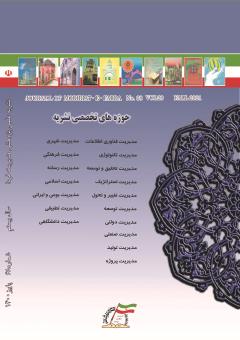Identifying the effective actors of forex trading network in the NIMA system using social network analysis
Subject Areas : مدیریت فناوری اطلاعاتMehrdad Agha Mohammad Ali Kermani 1 * , mohammad javad Rokhsat Talab 2 , Saeed Mirzamohammadi 3
1 - Associate Professor, Faculty of Management and Economics, Iran University of Science and Technology
2 - Associate Professor, Faculty of Management and Economics, Iran University of Science and Technology
3 - Senior expert in the field of macroeconomic and social systems engineering, Iran University of Science and Technology
Keywords: Buying and selling currency, analysis of social networks, ranking of actors, Nima system,
Abstract :
Nima system is an integrated system of foreign exchange transactions. Nima is a platform system that has been designed and implemented with the aim of managing the foreign exchange market. In this system, on the supply side, exporters can sell the currency from their exports, and on the demand side, importers can request to buy foreign currency. Identifying effective actors in each of these markets can have a positive impact on the policies of the main market maker of this system, the central bank.Using social networks analysis (SNA) tools can be a good way to achieve this. Since in these networks each of the actors can only have one of the roles of "buyer" or "seller" and there is only the possibility of trading and communication with the opposite role, these networks can be called bipartite networks. As a result, the usual approaches to identifying effective actors for these networks will not be usable. In contrast to standard approaches, we used a weighted projection algorithm to solve this problem. After projectting each of the two networks of foreign exchange supply and demand, four new networks are created, including the network of seller-exporters, buyer exchange offices, buyer importers, and seller exchange offices. Then We will try to make a method to score and rank the nodes. As a result of the implementation of the algorithm, a ranking was provided for the nodes, based on which the node with the highest rank will be the most important node in our network. Finally, in order to make suggestions to the policymaker, by analyzing the results of the ranking, questions about effective market players were answered.
Jackson, M. O. (2010). Social and economic networks. Princeton university press
Pesántez Cabrera, P. G. (2018). Bipartite Network Community Detection: Algorithms and Applications
Xiao, B., Huang, M., & Barnes, A. J. (2015). Network closure among sellers and buyers in social commerce community. Electronic Commerce Research and Applications, 14(6), 641-653.
Wang, J. C., & Chiu, C. C. (2008). Recommending trusted online auction sellers using social network analysis. Expert Systems with Applications, 34(3), 1666-1679.
Lam, H. W., & Wu, C. (2009, May). Finding influential ebay buyers for viral marketing a conceptual model of BuyerRank. In 2009 International Conference on Advanced Information Networking and Applications (pp. 778-785). IEEE.
Leem, B., & Chun, H. (2014). An impact of online recommendation network on demand. Expert systems with applications, 41(4), 1723-1729.
Dreżewski, R., Sepielak, J., & Filipkowski, W. (2015). The application of social network analysis algorithms in a system supporting money laundering detection. Information Sciences, 295, 18-32.
Giurca, A., & Metz, T. (2018). A social network analysis of Germany’s wood-based bioeconomy: Social capital and shared beliefs. Environmental innovation and societal transitions, 26, 1-14.
Lin, S. J., Jheng, Y. Y., & Yu, C. H. (2012). Combining ranking concept and social network analysis to detect collusive groups in online auctions. Expert Systems with Applications, 39(10), 9079-9086
Cheah, I., & Shimul, A. S. (2018). Consumer ethnocentrism, market mavenism and social network analysis. Australasian Marketing Journal (AMJ), 26(3), 281-288.
Newman, M. E., & Girvan, M. (2004). Finding and evaluating community structure in networks. Physical review E, 69(2), 026113
Alzahrani, T., & Horadam, K. J. (2016). Community detection in bipartite networks: Algorithms and case studies. In Complex systems and networks (pp. 25-50). Springer, Berlin, Heidelberg.
Guimerà, R., Sales-Pardo, M., & Amaral, L. A. N. (2007). Module identification in bipartite and directed networks. Physical Review E, 76(3), 036102.
Barber, M. J. (2007). Modularity and community detection in bipartite networks. Physical Review E, 76(6), 066102
Fortunato, S. (2010). Community detection in graphs. Physics reports, 486(3-5), 75-174
Liu, J., Xiong, Q., Shi, W., Shi, X., & Wang, K. (2016). Evaluating the importance of nodes in complex networks. Physica A: Statistical Mechanics and its Applications, 452, 209-219.
Yadav, V., Karmakar, S., Kalbar, P. P., & Dikshit, A. K. (2019). PyTOPS: A Python based tool for TOPSIS. SoftwareX, 9, 217-22

